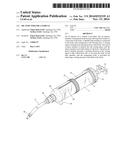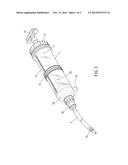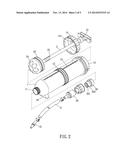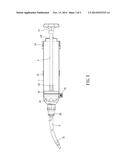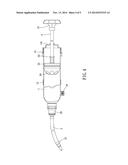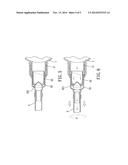Patent application title: OIL INJECTOR FOR A VEHICLE
Inventors:
Ying-Chieh Liao (Taichung City, TW)
Ying-Chieh Liao (Taichung City, TW)
Yu-Kuo Liao (Taichung City, TW)
Yu-Kuo Liao (Taichung City, TW)
IPC8 Class: AF16N308FI
USPC Class:
184 28
Class name: Force feed pumps hand-operated
Publication date: 2014-11-13
Patent application number: 20140332319
Abstract:
An oil injector for a vehicle is provided. The oil injector includes a
transparent body having a flowing hole formed on a front end of the body.
A flexible tube member is connected to the body and corresponds to the
flowing hole. A storing space is formed in an internal portion of the
body. One end of a piston member is entered into the storing space, and
the piston member is movable relative to the body. Therefore, the piston
member provides a pushing function in the storing space so that a fluid
flows into or out form the body via the tube member, and the transparent
body is provided for observing a storing amount of the fluid in the body.Claims:
1. An oil injector for a vehicle comprising: a body being transparent and
having a flowing hole formed at a front end thereof, a flexible tube
member connected to the body and corresponding to the flowing hole, a
storing space formed in an internal portion of the body; and one end of a
piston member entered into the storing space, the piston member being
movable relative to the body; wherein, the piston member provides a
pushing function in the storing space so that a fluid flows into or out
from the body via the tube member, and the transparent body is provided
for observing a storing amount of the fluid in the body.
2. The oil injector for a vehicle as claimed in claim 1, wherein an indicator is disposed on the body for observing the storing amount of the fluid in the internal portion of the body.
3. The oil injector for a vehicle as claimed in claim 1, wherein a valve member and a controlling member are disposed at the flowing hole of the body; the valve member is correspondingly assembled to the flowing hole; the controlling member is movable between a first position and a second position relative to the valve member for controlling a flowing amount between the valve member and the tube member; a rib portion and at least one through hole are disposed at a front end of the valve member; when the controlling member is located at the first position, the rib portion does not abut against an internal wall of the controlling member, so that the flowing hole communicates with the through hole and the tube member; when the controlling member is located at the second position, the rib portion abuts against the internal wall of the controlling member, so that the through hole does not communicate with the tube member.
4. The oil injector for a vehicle as claimed in claim 1, wherein at least one groove is formed at a front end of the piston member for reducing a weight and a producing material of the piston member.
5. The oil injector for a vehicle as claimed in claim 1, wherein an external circumference of the body is sleeved by an anti-skid member for being conveniently held.
6. The oil injector for a vehicle as claimed in claim 1, wherein one end of the body has an opening communicating with the storing space; a cover is assembled to the body for sealing the opening; the fluid is allowed to flow into the storing space via the opening.
7. The oil injector for a vehicle as claimed in claim 1, wherein an external circumference of one end of the piston member is sleeved by a pressing member which abuts against an internal wall of the storing space; the body has at least one air hole disposed between the pressing member and one end of the body for adjusting an air pressure in the storing space, so that the piston member is movable relative to the body.
8. The oil injector for a vehicle as claimed in claim 7, wherein the at least one air hole is disposed on the cover for adjusting an air pressure in the storing space, so that the piston member is movable relative to the body.
9. The oil injector for a vehicle as claimed in claim 7, wherein an external side of the pressing member is formed as cone-shaped for reducing a friction between the pressing member and the internal wall of the storing space and increasing a sealing efficiency.
10. The oil injector for a vehicle as claimed in claim 1, wherein a frame is assembled on an external circumference of the body for supporting the body.
11. The oil injector for a vehicle as claimed in claim 1, wherein a metallic positioning member is assembled at one end of the tube member.
12. The oil injector for a vehicle as claimed in claim 1, wherein one end of the piston member is formed as a hemisphere to have the piston member smoothly abut against an internal wall of the storing space.
Description:
BACKGROUND OF THE INVENTION
[0001] 1. Field of the Invention
[0002] The present invention relates to an oil injector.
[0003] 2. Description of the Prior Art
[0004] In a conventional oil supplying way for a vehicle, generally, a user opens an opening of an oil tank of the vehicle and handholds an oil can (such as a gasoline or a brake oil) to pour an oil into the opening of the oil tank for supplying a proper oil amount. However, the conventional oil supplying way would have the oil be carelessly dripped out from the oil tank; thereby the oil is wasted and an environment is polluted. Thus, a conventional oil supplying apparatus is provided for overcoming said waste and pollution.
[0005] The conventional oil supplying apparatus comprises a tube body and a piston. The tube body is made of a metallic material and is provided for receiving oil. The piston is movable in the tube body for pressing the oil in the body, so that a user could operate the piston to supply the oil into an oil tank via the tube body.
[0006] However, the tube body of the conventional oil supplying apparatus is non-transparent, such that the user cannot know a storing amount of the oil in the tube body. Therefore, the user would supply insufficient oil into the oil tank, or the oil would easily remain in the tube body.
[0007] Another conventional oil supplying apparatus comprises an oil storing body and a controlling member. The oil storing body is placed into an oil tank, and the controlling member is located at an external position of the oil tank, so that a user could operate the controlling member to supply the oil into the oil tank.
[0008] However, the user cannot observe a residual amount of the oil in the oil storing body. When the user releases the oil storing body from the oil tank, the residual oil would be easily dripped out from the oil storing body; thereby the residual oil is wasted and an environment is polluted. Therefore, the conventional oil supplying apparatus needs to be improved.
[0009] The present invention is, therefore, arisen to obviate or at least mitigate the above mentioned disadvantages.
SUMMARY OF THE INVENTION
[0010] An object of the present invention is to provide an oil injector for a vehicle, in which the oil injector could provide a function for observing a fluid storing amount and be conveniently operated.
[0011] To achieve the above and other objects, an oil injector for a vehicle is provided. The oil injector includes a transparent body having a flowing hole formed on a front end of the body. A flexible tube member is connected to the body and corresponds to the flowing hole. A storing space is formed in an internal portion of the body. One end of a piston member is entered into the storing space, and the piston member is movable relative to the body. An indicator is disposed on the body. A metallic positioning member is assembled on one end of the tube member.
[0012] Therefore, the piston member provides a pushing function in the storing space so that a fluid flows into or out from the body via the tube member. The positioning member could be firmly inserted onto an opening of an oil tank. The transparent body is provided for observing a storing amount of the fluid in the body.
[0013] Besides, a valve member and a controlling member are disposed at the flowing hole of the body. The valve member is correspondingly assembled to the flowing hole. The controlling member is movable between a first position and a second position relative to the valve member for controlling a flowing amount between the valve member and the tube member.
[0014] A rib portion and a through hole are disposed on a front end of the valve member.
[0015] When the controlling member is located at the first position, the rib portion does not abut against an internal wall of the controlling member, so that the flowing hole communicates with the through hole and the tube member. When the controlling member is located at the second position, the rib portion abuts against the internal wall of the controlling member, so that the through hole does not communicate with the tube member. Thereby a user could adjust an inflow amount or an outflow amount of the body via the controlling member.
[0016] The present invention will become more obvious from the following description when taken in connection with the accompanying drawings, which show, for purpose of illustrations only, the preferred embodiment(s) in accordance with the present invention.
BRIEF DESCRIPTION OF THE DRAWINGS
[0017] FIG. 1 is a perspective view of an oil injector for a vehicle according to a preferred embodiment of the present invention;
[0018] FIG. 2 is an exploded perspective view of the present invention;
[0019] FIGS. 3-4 are cross-sectional views of the present invention for showing a piston member is movable relative to a body for pushing an oil; and
[0020] FIGS. 5-6 are cross-sectional views of the present invention for showing a controlling member is rotatable relative to a valve member for the oil to flow from the body into a tube member.
DETAILED DESCRIPTION OF THE PREFERRED EMBODIMENTS
[0021] FIGS. 1-2 show an oil injector for a vehicle according to a preferred embodiment of the present invention. The oil injector includes a body 1 which is transparent, a piston member 2 and a flexible tube member 3.
[0022] The body 1 is a transparent tube and has a storing space formed in an internal portion thereof. A flowing hole 11 is formed at one end of the body 1 and communicates with the storing space. An opening 12 is formed at another end of the body 1, and a fluid can be allowed to flow into the storing space via the opening 12. The body 1 has an indicator 13 axially disposed along a longitudinal portion thereof.
[0023] A cover 14 is assembled to the body 1 for sealing the opening 12. One end of the piston member 2 is entered into the storing space of the body 1, and another end of the piston member 2 passes through the cover 14 and has a handle 21 assembled thereon. An external circumference of one end of the piston member 2 is sleeved by two pressing members 22 (the pressing member 22 might be an O-ring) which are spaced from each other. The pressing member 22 could tightly abut against an internal wall of the storing space. An external side of the pressing member 22 is formed as cone-shaped, so that the external side of the pressing member 22 could flexibly abut against the internal wall of the storing space, so as to reduce a friction between the pressing member 22 and the internal wall of the storing space and increase a sealing efficiency.
[0024] One end of the piston member 2 is formed as a hemisphere so as to have the piston member 2 smoothly abut against the internal wall of the storing space; thereby the piston member 2 could be smoothly moved relative to the body 1.
[0025] The piston member 2 is sleeved by an elastic member 23 so as to provide a recovery function for the piston member 2. Besides, at least one air hole 141 is opened on the cover 14 for adjusting an air pressure in the storing space, so that the piston member 2 is movable relative to the body 1. At least one groove 24 is formed at a front end of the piston member 2 for reducing a weight and a producing material of the piston member 2.
[0026] An external circumference of the body 1 is sleeved by an anti-skid member 15 for a user to conveniently hold the body 1. A frame 16 is assembled on the external circumference of the body 1 for firmly supporting the body 1.
[0027] One end of the tube member 3 is correspondingly connected to the flowing hole 11 of the body 1, and another end of the tube member 3 has a metallic positioning member 31 assembled thereon. The positioning member 31 could be firmly connected to an opening of an oil tank, so that the fluid can flow into or flow out from the body 1 via the tube member 3.
[0028] Referring to FIGS. 1 and 5-6, the present invention comprises a valve member 32 and a controlling member 33. The valve member 32 is correspondingly assembled to the flowing hole 11. The controlling member 33 is movable between a first position and a second position relative to the valve member 32 for controlling a flowing amount between the valve member 32 and the tube member 3.
[0029] In the embodiment, the controlling member 33 is rotatably assembled relative to the valve member 32. The valve member 32 is screwed to the body 1 and communicates with the flowing hole 11.
[0030] A rib portion 321 and a through hole 322 are disposed at a front end of the valve member 32.
[0031] When the controlling member 33 is rotated to the first position, the rib portion 321 does not abut against an internal wall of the controlling member 33, so that the flowing hole 11 communicates with the through hole 322 and the tube member 3 (as shown in FIG. 6). When the controlling member 33 is rotated to the second position, the rib portion 321 abuts against the internal wall of the controlling member 33, so that the through hole 322 does not communicate with the tube member 3 (as shown in FIG. 5).
[0032] Referring to FIGS. 3-4, when the user wants to supply oil into the oil tank or to exhaust the oil from the oil tank of a vehicle (said supplement is an example of the embodiment), the user could supply the oil into the body 1 via the opening 12, so that the oil is located between one end of the piston member 2 and the flowing hole 11; thereafter, the user operates the handle 21 to drive the piston member 2 to move relative to the body 1, so as to have the oil flow into the tube member 3 via the flowing hole 11 and the valve member 32. Moreover, the positioning member 31 of one end of the tube member 3 could be positioned at the opening of the oil tank, so that the oil can flow from the tube member 3 of the body 1 into the oil tank.
[0033] Thus, the user could observe the transparent body 1 and the indicator 13 for actually realizing a residual amount of the oil in the storing space of the body 1; thereby the user could decide a proper amount of the oil in the body 1 before said supplement, or the user could remove the body 1 from the oil tank after all the oil is supplied into the oil tank. Thus, the oil would not be dripped out form the body 1 for avoiding a waste of the oil and a pollution of an environment.
[0034] Moreover, the user could adjust a flow area between the valve member 32 and the tube member 3 via the controlling member 33, so as to adjust a flow rate and a flow velocity of the oil which flows into the oil tank. Furthermore, the groove 24 which is formed at a front end of the piston member 2 could effectively reduce a weight and a producing material of the piston member 2.
[0035] Under above arrangement, the present invention actually provides a convenient function for observing the residual amount of the oil in the body 1, and is also conveniently operated to supply the oil into the body 1.
[0036] Although particular embodiments of the invention have been described in detail for purposes of illustration, various modifications and enhancements may be made without departing from the spirit and scope of the invention. Accordingly, the invention is not to be limited except as by the appended claims.
User Contributions:
Comment about this patent or add new information about this topic:
| People who visited this patent also read: | |
| Patent application number | Title |
|---|---|
| 20200374132 | SYSTEMS AND METHODS FOR MAINTAINING DECENTRALIZED DIGITAL IDENTITIES |
| 20200374131 | METHOD AND SYSTEM FOR GENERALIZED PROVENANCE SOLUTION FOR BLOCKCHAIN SUPPLY CHAIN APPLICATIONS |
| 20200374130 | SECURE REPLACEABLE VERIFICATION KEY ARCHITECTURE IN A MEMORY SUB-SYSTEM |
| 20200374129 | SYSTEMS AND METHODS FOR CREATING A DIGITAL ID RECORD AND METHODS OF USING THEREOF |
| 20200374128 | DISTRIBUTED TIERED DATA EXCHANGES WITHIN A BLOCKCHAIN NETWORK |

